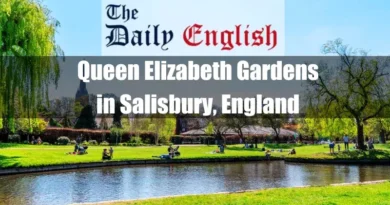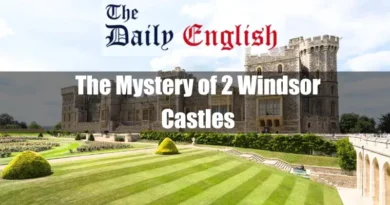I. History of State Apartments at Windsor Castle
The State Apartments at Windsor Castle are grand rooms for ceremonial occasions and state visits. They are located in the Upper Ward of the castle and were originally built in the 14th century by Edward III. However, the interiors have been repeatedly reworked on the most opulent scale by a succession of monarchs.

A. Edward III and the Origins of the State Apartments
In the 14th century, Edward III transformed the medieval fortress at Windsor into a magnificent palace, and the State Apartments were a key part of this transformation. Edward III used the apartments for various purposes, including hosting royal banquets, receiving foreign dignitaries, and holding court. The apartments were originally decorated in a Gothic style, with richly carved woodwork and painted walls.
B. Charles II and the Baroque Era
After the English Civil War and the Restoration of the monarchy in 1660, Charles II set out to modernize the State Apartments. He commissioned the architect Hugh May to redesign the interiors in a Baroque style. May’s work included adding elaborate plasterwork, installing gilded mirrors, and commissioning paintings by famous artists like Antonio Verrio. The result was a series of stunning rooms that reflected the opulence and grandeur of the Baroque era.
C. George III and Neoclassicism
In the 18th century, King George III and his wife, Queen Charlotte, continued to modernize the State Apartments. They commissioned the architect James Wyatt to redesign the interiors in a Neoclassical style. Wyatt’s work included removing some of May’s Baroque ornamentation and replacing it with more restrained Neoclassical designs. The result was a series of elegant rooms reflecting the prevailing classicist taste.
- Queen Elizabeth Gardens in Salisbury, England
- The Old Court Arts Centre, Windsor’s History & Today
- St. George’s Chapel at Windsor Castle in History & Today
D. George IV and the Romantic Revival
In the early 19th century, King George IV and his wife, Queen Caroline of Brunswick, further embellished the State Apartments. They commissioned the architect Sir Jeffry Wyatville to add Gothic and Rococo elements to the interiors. Wyatville’s work also included creating new rooms, such as the Crimson Drawing Room and the Grand Reception Room. The result was a series of rooms that reflected the eclectic taste of the Romantic Revival era.
E. Queen Victoria and the Victorian Era
Queen Victoria made only a few minor changes to the State Apartments during her reign. However, she did use the apartments extensively for state visits and other ceremonial occasions. The State Apartments were also used to marry Queen Victoria’s eldest son, Albert, Prince of Wales, to Alexandra of Denmark in 1863.
F. The 20th Century and Beyond
In the 20th century, the State Apartments were damaged by two fires, in 1947 and 1992. However, both fires were extinguished, and the apartments were painstakingly restored. The State Apartments are now open to the public and are one of the most popular tourist attractions at Windsor Castle.
The State Apartments are a stunning example of British royal architecture and design today. They are a testament to the enduring power of the monarchy and the rich history of Windsor Castle.
- Also, read Windsor Castle Opening Times: Everything You Need to Know.
- Also, read Windsor Castle Tickets: A Proven Comprehensive Guide.
II. State Apartments at Windsor Castle Architecture

The State Apartments at Windsor Castle encapsulate a remarkable blend of architectural styles that reflect successive monarchs’ evolving tastes and preferences. From the Gothic grandeur of the 14th century to the Neoclassical elegance of the 18th century, each era has left its indelible mark on these grand spaces.
A. Medieval Gothic:
The original State Apartments, constructed under Edward III in the 14th century, exemplified the Gothic style, characterized by pointed arches, ribbed vaults, and intricate stonework. The Gothic elements were evident in the apartments’ structural design, ornamentation, and overall ambience.
B. Baroque Splendor:
King Charles II’s extensive renovations in the 17th century introduced the Baroque style to the State Apartments. Hugh May, the appointed architect, transformed the interiors with lavish plasterwork, gilded mirrors, and opulent furnishings. The Baroque influence was evident in the rooms’ grandeur, dramatic lighting, and overall sense of theatricality.
- Also, know about The Best Bits of Windsor Castle
- And The Windsor Castle Dogs.
C. Neoclassical Refinement:
During the reign of George III and Queen Charlotte in the 18th century, the State Apartments transformed the Neoclassical style. James Wyatt, the architect responsible for this shift, replaced Baroque ornamentation with clean lines, restrained decoration, and classical motifs. The Neoclassical style brought the apartments a sense of order, balance, and elegance.
D. Romantic Revival Eclecticism:
King George IV and Queen Caroline of Brunswick’s patronage in the early 19th century blended Gothic and Rococo elements into the State Apartments. Sir Jeffry Wyatville, the architect tasked with this transformation, incorporated Gothic arches, pointed windows, and Rococo ornamentation. The Romantic Revival style infused the apartments with whimsy, romance, and eclecticism.
Windsor Guildhall Near Windsor Castle: Past and Today
E. Preservation and Restoration:
Throughout history, the State Apartments have undergone numerous renovations and restorations to preserve their architectural integrity. The devastating fires of 1947 and 1992 necessitated significant restoration efforts, which were meticulously carried out to retain the original architectural elements and ensure the continued splendour of these historic spaces.
Today, the State Apartments stand as a testament to the architectural evolution of Windsor Castle, reflecting the changing tastes and artistry of British monarchs over the centuries. The interplay of architectural styles creates a unique and captivating tapestry, showcasing this iconic royal residence’s rich history and enduring legacy.
- Also, read Windsor Castle Changing of the Guard: Where History Coming Alive.
- Also, read Windsor Castle Tour: A Comprehensive and Best Guide.
- Also, read Windsor Castle Tickets Advantage Card: Know Everything.
III. State Apartments Royal Ceremonies
The State Apartments at Windsor Castle have long served as a grand backdrop for various royal ceremonies, playing a pivotal role in showcasing the majesty and traditions of the British monarchy. These grand spaces have hosted countless investitures, state visits, banquets, and other ceremonial occasions, each steeped in history and protocol.
A. Investitures:
Formal ceremonies where the monarch bestows honours and awards upon distinguished individuals have regularly occurred in the State Apartments since the 18th century. The Throne Room, with its imposing throne canopy and intricate plasterwork, serves as the ceremonial setting, where the monarch presents the honours to recipients amidst a gathering of dignitaries and guests.
B. State Visits:
The State Apartments provide a magnificent setting for receiving foreign dignitaries on state visits. With its vast expanse and opulent décor, the Grand Reception Room offers a fitting stage for welcoming heads of state and other distinguished guests. The ceremonial procession through the State Apartments, accompanied by military fanfare and royal protocol, underscores the grandeur and significance of these diplomatic encounters.
C. Royal Banquets:
The State Apartments have hosted countless royal banquets throughout history, providing a lavish setting for grand celebrations and state dinners. The Crimson Drawing Room, with its vibrant red silk walls and exquisite portraits, creates an ambience of elegance and opulence, while the Waterloo Chamber, adorned with battle scenes commemorating Britain’s victory, lends a sense of historical grandeur to these formal gatherings.
D. Other Ceremonial Occasions:
The State Apartments have also served as the venue for various other ceremonial occasions, including royal weddings, christenings, and jubilees. The St George’s Hall, with its grand vaulted ceiling and historical significance, has provided a picturesque setting for these momentous events, capturing the essence of royal tradition and splendour.
These ceremonial gatherings celebrate and commemorate significant occasions and reinforce the enduring legacy of the British monarchy and the State Apartments’ role in its history. The grandeur of the surroundings, the rich tapestry of architectural styles, and the weight of history combine to create an atmosphere of awe and respect, underscoring the significance of these royal ceremonies.
- Also, read Exploring Buckingham Palace to Windsor Castle Journey.
- Also, read How Far is Windsor Castle from Buckingham Palace? Royal Mile?
IV. Windsor Castle State Apartments Tours

A. Standard Tours:
Explore the State Apartments on a guided tour led by knowledgeable and engaging guides who provide insights into each room’s history, architecture, and significance—Marvel at the opulent décor, intricate craftsmanship, and priceless artworks that adorn these grand spaces.
- Queen Mary’s Dolls’ House: Step into a world of miniature enchantment with Queen Mary’s Dolls’ House, a masterpiece of craftsmanship and a unique glimpse into early 20th-century domestic life.
B. Exclusive Tours:
Delve deeper into the history and splendour of the State Apartments with exclusive tours that offer a more intimate and personalized experience. Explore fascinating areas not accessible on standard tours and gain richer insights from your expert guide.
- Evening Tours: Experience the State Apartments in a unique and atmospheric setting, illuminated by soft lighting and accompanied by live music.
Additional Information:
- Tours are available in multiple languages.
- Photography is generally not permitted within the State Apartments.
- Booking is recommended to secure your preferred tour time.
Whether you choose a standard tour or an exclusive experience, exploring the State Apartments at Windsor Castle is an unforgettable journey into the heart of British royalty, where history and grandeur intertwine to create a truly captivating experience.
V. State Apartments Art Collection

The State Apartments at Windsor Castle house an impressive collection of artworks spanning centuries, reflecting the artistic tastes and patronage of British monarchs. These masterpieces adorn the grand walls and corridors, enriching the historical tapestry and grandeur of these iconic spaces.
A. Key Highlights
- Renaissance to Later Periods: The State Apartments boast a rich collection of paintings from the Renaissance period and beyond. While specific attributions require verification through the Royal Collection website or official sources, renowned artists are well represented.
- Baroque and Beyond: Explore works by prominent artists like Antonio Verrio, whose allegorical ceiling paintings grace the King’s Dining Room and Queen’s Drawing Room, exemplifying the Baroque style’s drama and movement.
- Sculpture and Decorative Arts: Beyond paintings, the State Apartments showcase a collection of sculptures and decorative arts. Marble busts of historical figures, exquisite Sèvres porcelain adornments, and tapestries depicting mythological and historical scenes add depth and texture to these grand spaces.
Immerse Yourself in Art and History
The State Apartments’ art collection creates a harmonious blend of visual beauty and historical significance. As you explore these grand spaces, you’ll be captivated by the artistic masterpieces, further enriching your experience of royal grandeur.
VI. State Apartments Special Exhibitions

The State Apartments at Windsor Castle frequently host special exhibitions that delve into specific aspects of royal history, artistry, and cultural heritage. These curated displays offer visitors a deeper understanding of the castle’s rich tapestry and the enduring legacy of the British monarchy.
A. Types of Special Exhibitions:
- Historical Exhibitions: These exhibitions explore various periods of royal history, featuring artefacts, portraits, and documents that provide insights into the lives of monarchs, their courts, and the events that shaped their reigns.
- Artistic Exhibitions: These exhibitions showcase art from the Royal Collection, highlighting British monarchs’ diverse tastes and patronage. Paintings, sculptures, and decorative art from various periods are displayed, offering a glimpse into the artistic trends and influences that shaped the castle’s interiors.
- Cultural Exhibitions: These exhibitions explore the cultural and social impact of the monarchy, examining the role of the State Apartments in state ceremonies, diplomatic relations, and the arts. Costumes, furnishings, and other artefacts provide a window into different eras’ customs, traditions, and aesthetic sensibilities.
B. Significance of Special Exhibitions:
- Enrich Visitors’ Experience: Special exhibitions complement the standard tours of the State Apartments, providing a more focused and in-depth exploration of specific themes or periods.
- Highlight Hidden Gems: These exhibitions often showcase lesser-known aspects of the castle’s collection or delve into specific areas not typically accessible on standard tours.
- Offer Fresh Perspectives: Special exhibitions bring in new curatorial voices and perspectives, enriching the understanding of the State Apartments and their historical context.
Whether delving into the grandeur of royal ceremonies, exploring the artistry of renowned masters, or examining the cultural impact of the monarchy, special exhibitions at the State Apartments at Windsor Castle provide visitors with a deeper appreciation of the castle’s rich heritage and enduring significance.
VII. Windsor State Apartments Restoration
The State Apartments at Windsor Castle have undergone numerous renovations and restorations throughout history, reflecting successive monarchs’ changing tastes and architectural preferences. However, two significant fires in the 20th century, in 1947 and 1992, caused extensive damage, requiring major restoration efforts.
A. 1947 Fire and Restoration:
1947, a fire broke out in the Private Chapel, quickly spreading to the State Apartments. The flames caused severe damage to the interiors, destroying ceilings, woodwork, and numerous artworks. A team of skilled craftsmen and conservators was assembled to undertake the restoration for several years. The restoration involved meticulous attention to detail, ensuring the original architectural features and decorative elements were faithfully recreated.
B. 1992 Fire and Restoration:
In 1992, a more devastating fire engulfed the State Apartments, destroying over 100 rooms and causing substantial damage to the castle’s infrastructure. The fire, which originated from a spotlight in the Private Chapel, spread rapidly due to the presence of old wiring and combustible materials. The damage was immense, with entire rooms reduced to shells and priceless artworks and furnishings lost to the flames.
The restoration effort following the 1992 fire was the most ambitious and challenging in the castle’s history. A team of over 250 experts, including architects, engineers, conservators, and art historians, was assembled to oversee the project. The restoration process took five years and was guided by a set of key principles:
- Authenticity: The restoration aimed to recreate the State Apartments as they were before the fire, using traditional techniques and materials.
- Sensitivity: The restoration team was mindful of the castle’s historical significance and sought to preserve its unique character and charm.
- Innovation: The restoration project also incorporated innovative techniques and technologies to ensure the long-term preservation of the castle’s fabric.
1. Challenges and Achievements:
The restoration of the State Apartments presented numerous challenges, including:
- The scale of the damage: The extent of the fire damage was immense, requiring a comprehensive and meticulous approach to restoration.
- The complexity of the work: The State Apartments feature a variety of architectural styles and decorative elements, demanding a high level of craftsmanship and expertise from the restoration team.
- The need for authenticity: The restoration team had to balance the need for authenticity with incorporating modern fire safety measures.
Despite these challenges, the restoration project was a remarkable success, achieving the following:
- The faithful recreation of the State Apartments: The restored State Apartments closely resemble their pre-fire appearance, showcasing the original design’s architectural grandeur and artistic splendour.
- The preservation of historical significance: The restoration process carefully preserved the castle’s historical integrity, ensuring that the unique character and charm of the State Apartments were retained.
- Incorporating modern safety measures: The restored State Apartments meet modern fire safety standards, ensuring the long-term protection of the castle’s fabric.
Embark on an enthralling journey through the very heart of Windsor Castle, where grandeur and history intertwine. Discover the captivating essence of the State Apartments, a testament to centuries of regal splendour. Unravel the tales of grand ceremonies, architectural marvels, and the meticulous preservation that keeps this historic gem alive. Step into a world of artistry, where masterpieces adorn the walls, and immerse yourself in the tapestry of royal life through exclusive tours. Prepare to be enchanted by the State Apartments of Windsor Castle, where every room whispers stories of regal grandeur, inviting you to step into a bygone era of luxury and splendour.










Comments are closed.